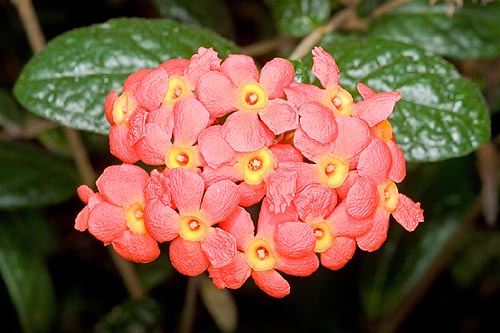Family : Rubiaceae

Text © Pietro Puccio

English translation by Mario Beltramini

Not common in spite of its fairly good ornamental characteristics © Giuseppe Mazza
The genus is honoured to the French naturalist Guillaume Rondelet (1507-1566); the Latin name of the species “odorata” = perfumed, with reference, maybe, to the slight scent emanated by the flowers during the night hours, or, more likely, to its fragrant roots.
Common names: “fragrant rondeletia”, “Panama rose” (English); “rondelecia”, “careicillo de monte”, “clavellina”, “cordobancillo” (Spanish); “rondelétie odorante”, “rondelétie écarlate” (French); “Rondeletie”, “Duftende”, “Duftende Rondeletie” (German).
Evergreen shrub, tall up to about 2,5 metres, with ovate-oblong, up to 10 cm long and 4 cm broad, leaves, rather coriaceous and rough to the touch, with deeply incised veins and curved margins of a dark green colour.
Inflorescences in terminal corymbs with flowers of about 13 mm of diameter, red or orange-red coloured with yellow centre; the fruits are about 4 mm long globose capsules, which contain several small seeds. It reproduces by seed and semi-woody cutting in summer.
Not very spread plant, in spite of its fairly good ornamental characteristics, represented by the foliage and by the showy inflorescences produced for a good part of the year, and its rather good rusticity.
It can be cultivated in tropical, subtropical and warm temperate areas, in full sun or partial shade, on soils preferably calcareous and kept humid during the vegetative period, even if, when adult, it can bear short periods of drought.
Synonyms: Rondeletia speciosa Lodd. (1832); Rondeletia coccinea Moc. & Sessé ex DC. (1830); Rondeletia odorata var. breviflora Hook.f. (1878).
→ To appreciate the biodiversity within the RUBIACEAE family please click here.
